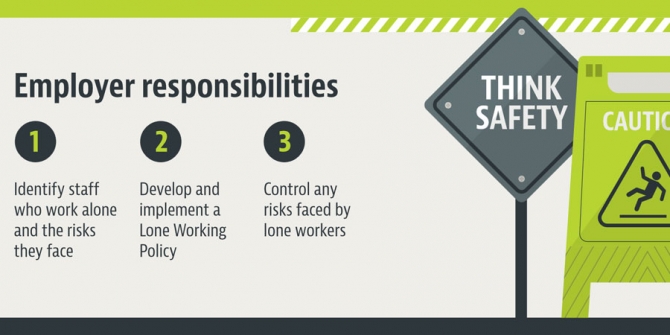Legislation does not prohibit lone working in a general sense, although there are some types of work which require supervision:
- Where young people are undergoing training
- Where work on live electrical equipment is being performed
- Work under the Construction (health & safety) Regulations
- Working at heights
- Working in confined spaces
- Working with hazardous substances
- Working with a high risk of violence from a member of the public
Establishing safe working conditions for people who work alone is no different to that of arranging the safety of other employees. Basically the employer needs to understand the law and standards that apply to all work-related activities which requires them to identify the hazards of the job and assess the risks involved. Then the employer needs to devise or implement any safe working arrangements so that risks are eliminated or effectively controlled.
Lone workers themselves too have a responsibility for their own safety and to co-operate with their employers in meeting their legal obligations. These responsibilities are inferred from the following UK legislation:

The Health and Safety at Work Act 1974 is the basis of British health and safety law and sets out the general duties of employers and employees to their own and each other’s safety. These duties are qualified in the Act by the principle of ‘so far as is reasonably practicable’. In other words an employer does not have to take measures to avoid or reduce the risk if they are technically impossible or if the time, trouble or cost of the measures would be grossly disproportionate to the risk.
What the law requires here is what good management and common sense would lead employers to do anyway: that is, to look at what the risks are and take sensible measures to tackle them.
The Management of Health and Safety at Work Regulations 1999: require employers in consultation with employees to carry out risk assessments, make arrangements to implement necessary measures, appoint competent people and arrange for appropriate information and training. Employers do need to check that lone workers have no medical conditions that make them unsuitable for working alone. In some cases this may entail seeking medical advice.


Health and Safety (Display Screen Equipment) Regulations 1992: set out requirements for work with Visual Display Units (VDUs).
Personal Protective Equipment at Work Regulations 1992: require employers to provide appropriate protective clothing and equipment for their employees which could include lone working devices and panic alarms.
Health and Safety (First Aid) Regulations 1981: cover requirements for first aid.
The Health and Safety Information for Employees Regulations 1989: require employers to display a poster telling employees what they need to know about health and safety.
Read article: Are you lone workers safe >

Provision and Use of Work Equipment Regulations 1998: require that equipment provided for use at work, including machinery, is safe.
Manual Handling Operations Regulations 1992: cover the moving of objects by hand or bodily force.
Employers’ Liability (Compulsory Insurance) Act 1969: require employers to take out insurance against accidents and ill health to their employees.
Reporting of Injuries, Diseases and Dangerous Occurrences Regulations 1995 RIDDOR): require Employer’s to notify certain occupational injuries, diseases and dangerous events.
Noise at Work Regulations 1989: require employers to take action to protect employees from hearing damage.
Electricity at Work Regulations 1989: require people in control of electrical systems to ensure they are safe to use and maintained in a safe condition.
Control of Substances Hazardous to Health Regulations 2002 (COSHH): require employers to assess the risks from hazardous substances and take appropriate precautions.
Confined Spaces Regulations 1997: require people working in such conditions to be safe.
Download a copy of our Lone Working Policy
Lone Workers are under increased threats from certain risks associated with their particular job. A Lone Worker Policy helps the business to assess any health and safety risks to an employee which can be relevant to a number of different situations in the workplace.
The assessment is essentially in the form of a risk assessment and can help decide whether the employee requires a lone worker device or something similar.
Download a copy of our Lone Worker Protection Implementation Guide
One of LONEALERT’s main aims is to help their customers with the implementation of lone worker protection systems.
This document is designed to help our new customers use the best possible practice to help ensure straightforward implementation of their new Lone Working Solution.







